AUGUST 24, 2011 — The California sun, reflecting off the surface of the Pacific Ocean and the white sand on Catalina Island’s Parsons Landing, blinds us, as we muscle our kayaks, after an exhausting two-day, 18-mile paddle, toward shore. When Natalie and I feel the tip of our car-lengthed, lime green kayak hit the sand, we jump into the cool salt water, and, with the last remaining muscle fibers in our aching shoulders and biceps, we drag the boat up the beach.
Natalie and I, along with the two other couples paddling with us — Rich & Wendy and Aaron & Bailey — collapse on the sand. Natalie, a talkative law student, passed my is-this-person-risk-interested-enough-for-me test by accepting my Independence-Day-weekend-kayaking-trip invitation without having any idea what she was getting into. In retrospect, it’s probably good that she didn’t know the details of our adventure. Yesterday morning, standing on Descanso Beach in Avalon near the southeastern end of Catalina, the six of us set off to try to be good Americans over the weekend of July 4, celebrating by taking three, two-person kayaks for an adventure comprising 35 miles of kayaking and six miles of hiking. We packed our kayak cargo holds with lots of gear, food, wine, board games, and a mysterious brown box with secret contents.
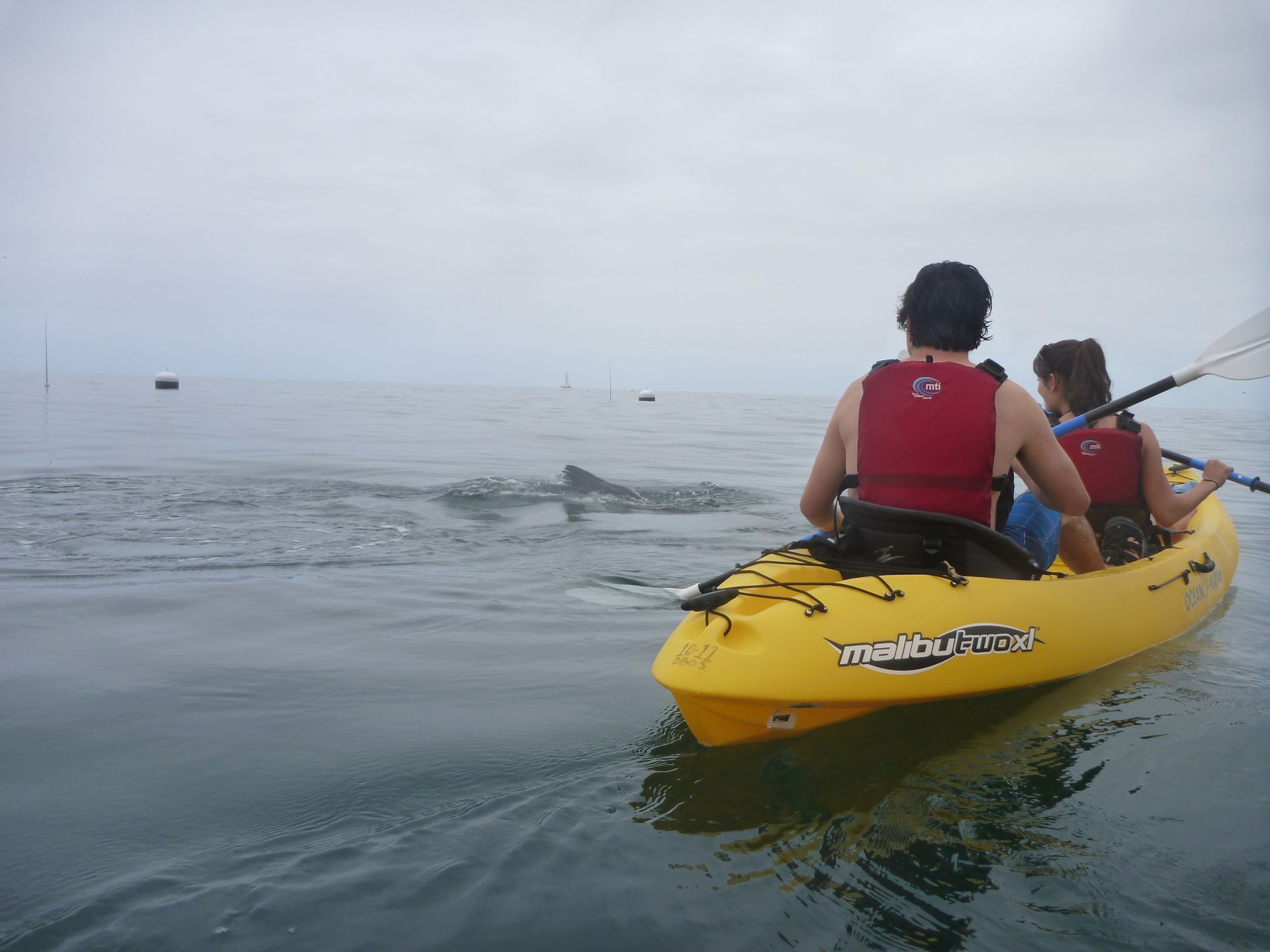
A seal jumps above the surface of the water next to a sea kayak near Catalina Island.
As she relaxes on the beach, Natalie, who has the dubious honor of possessing the fairest skin among us, covers herself with a rain tarp. We’ve discovered that sunscreen is absolutely no match against the six hours we’ve spent sitting on the surface of a huge body of shimmering salt water. Lying on the sand, even though my eyes are closed, I can still see the intense orb of the sun moving across the sky. I feel my skin slowly roasting to a perfectly-cooked medium-well. Even though she’s mostly covered by the tarp, Natalie is starting to look like a boiled lobster.
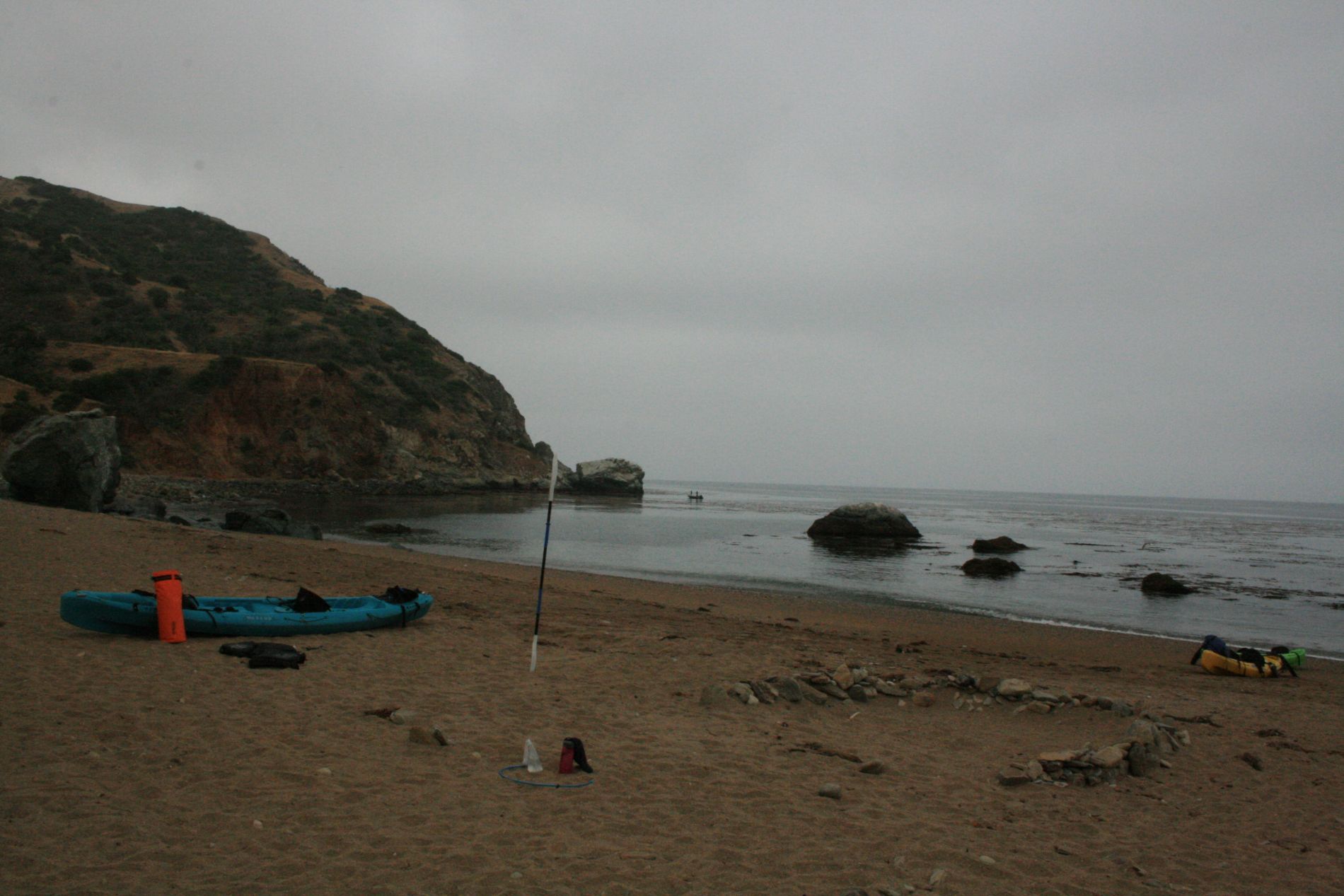
A kayak sits on Catalina Island’s Parsons Landing. (photo by Wendy Eckersley)
“Okay, this is the part where we hike up a mountain,” I announce half-heartedly, after we’ve been half-napping for 20 minutes. “Remember, it’s optional.” The other five let out a collective groan. But no one wants to be the wimp who’s opting to lie motionless on the beach while the rest of the group hikes five miles. So, one by one, each of us gets up, sighs loudly, and packs a backpack. I put the mysterious brown box into mine.
“I can’t believe we have to kayak another 18 miles — in one day — to get home tomorrow,” Bailey says. Despite her otherwise bubbly energy, she’s by far the least enthusiastic paddler of the group.
“It will all be worth it,” I reply.
With the sun hovering just above the horizon, the six of us hike, through large tracts of tall grass turned a rich golden brown by the sun and oases of gnarled, green eucalyptus trees, toward a mountain peak overlooking the island’s northern bays. In the distance, Natalie catches sight of what, at first, looks like a moving, brown rock the size of a small car, but turns out to be one of the Island’s famous 200 buffalo left behind in 1924, by a film production company making a Western.
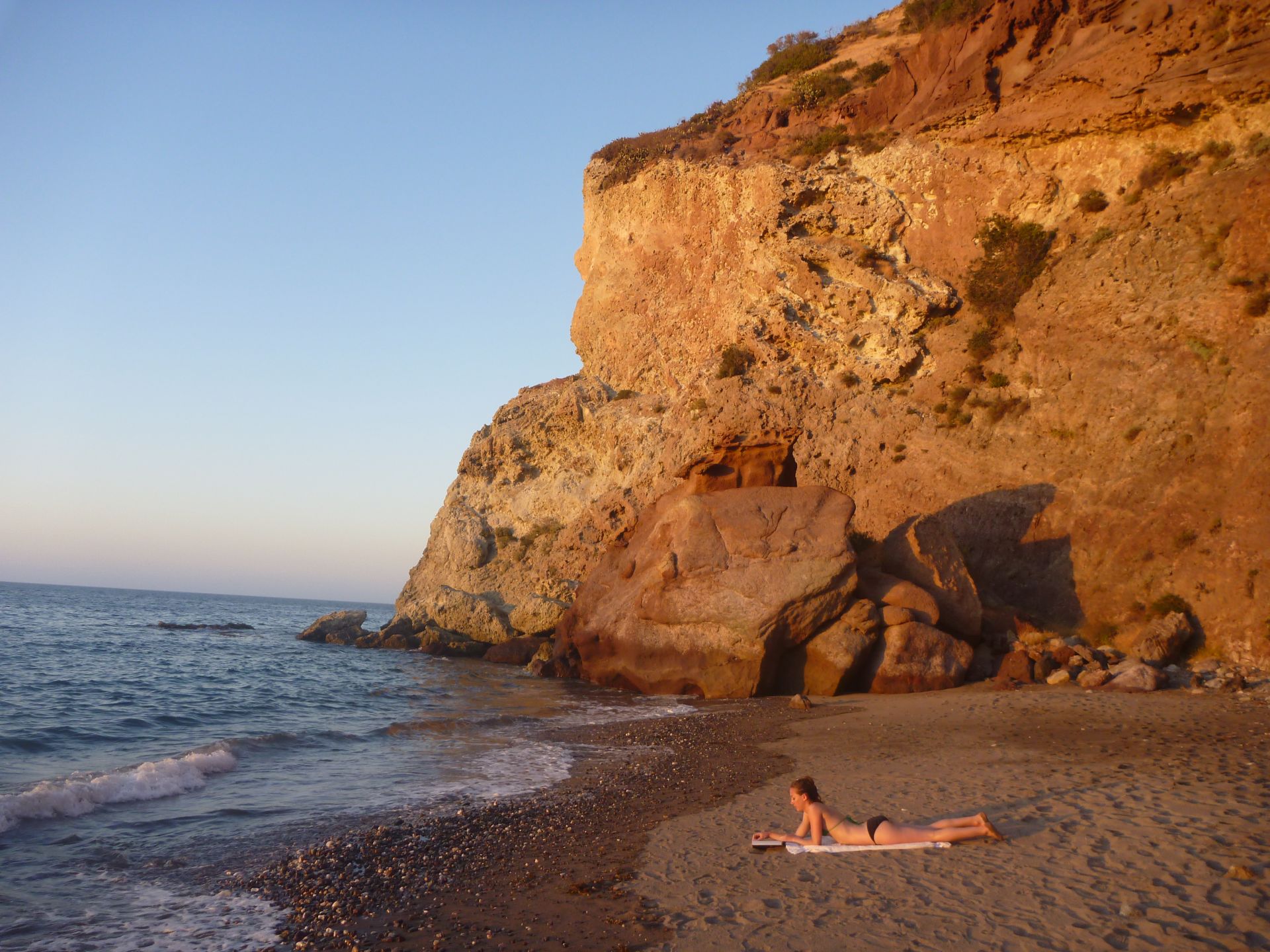
A woman reads a book on secluded Lava Wall beach on Catalina Island, California.
Soon, we hear the chatter and yelling of hundreds of children as we pass a bustling Cub Scout camp, hidden on a strip of land behind the rugged, rocky protrusion of Catalina’s Arrow Point. The area looks like the set of M*A*S*H, dotted with khaki-colored tents and clothing. In the middle of the encampment, we see what looks like a built-to-scale, landlocked pirate ship, and we begin to wonder whether this is a pirate training camp. Aaron (always willing to turn any situation toward the absurd), Rich (always suspecting that everything has a sinister backdrop) and I (always hoping to subvert hegemonies but rarely possessing the courage to do so) concoct plans to storm the possibly-evil Scout camp, board the ship, and take control of the high seas by raising our own flag on the mast. We don’t follow through.
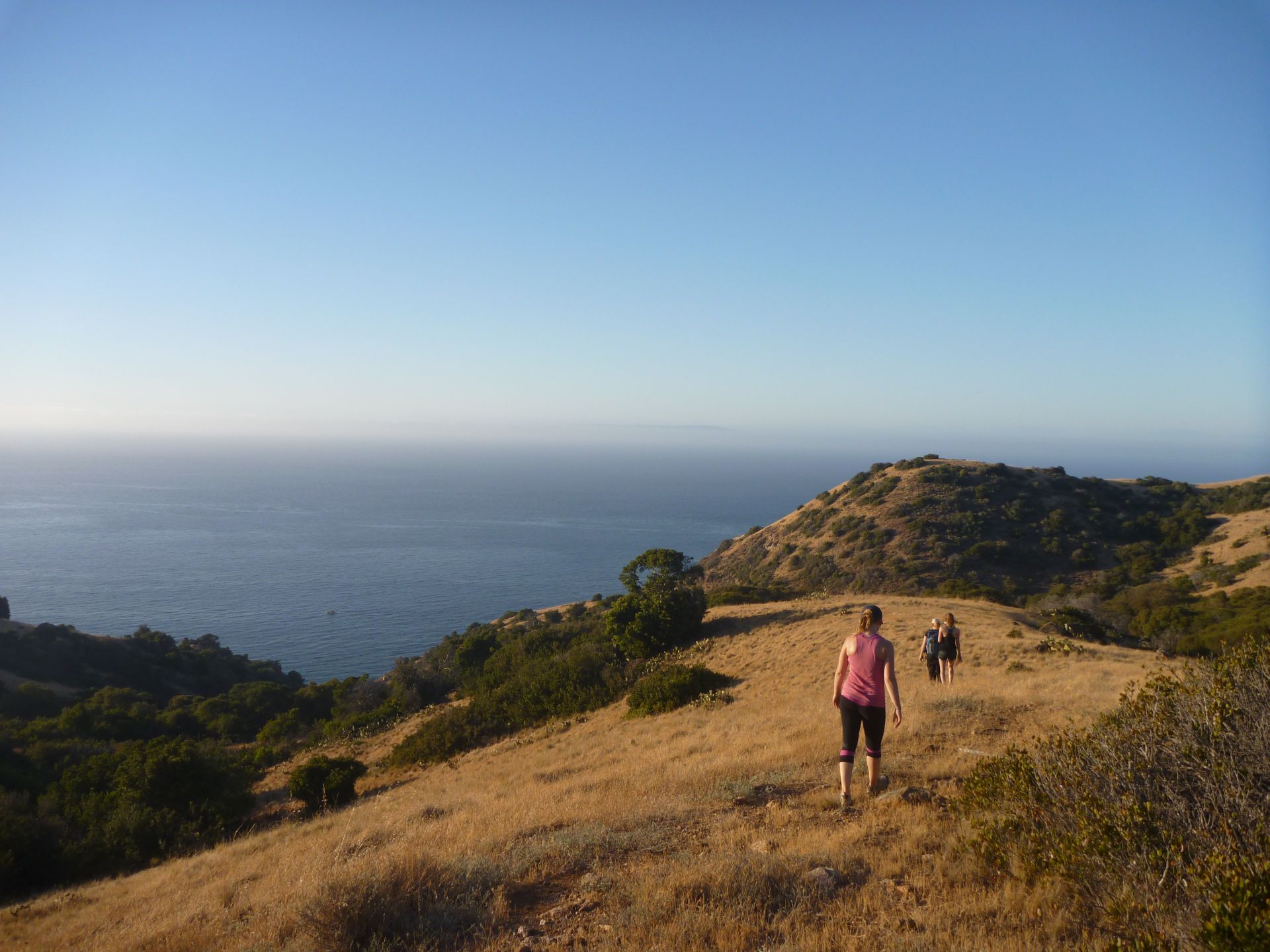
Hikers walk above the Lava Wall camp site below the Catalina Island airport.
When we reach the base of the mountain peak we’ve been aiming for, we see a steep, cactus-covered scree slope, taunting us. No one seems excited about the prospect of clawing our way to the top. Still hoping for a high view of the ocean, Wendy and Bailey take the lead and start walking through high weeds toward the island’s edge. Quickly, we find ourselves sitting on a dirt patch next to more tall, amber grass, a perfect vantage point overlooking the sparkling, blue inlet known as Emerald Bay. From here, we can see the birds, seals, and rocky outcrops that have comprised the last two days of our paddling trip. Hungry, we pull out the dinner-related apparatus that we’ve been lugging — pasta, garlic, capers, sausage, a strainer, and a large pot — and put it on the ground. Wendy balances the pot precariously on a tiny propane burner and begins boiling the pasta while Rich mixes a sauce to pour over the noodles.
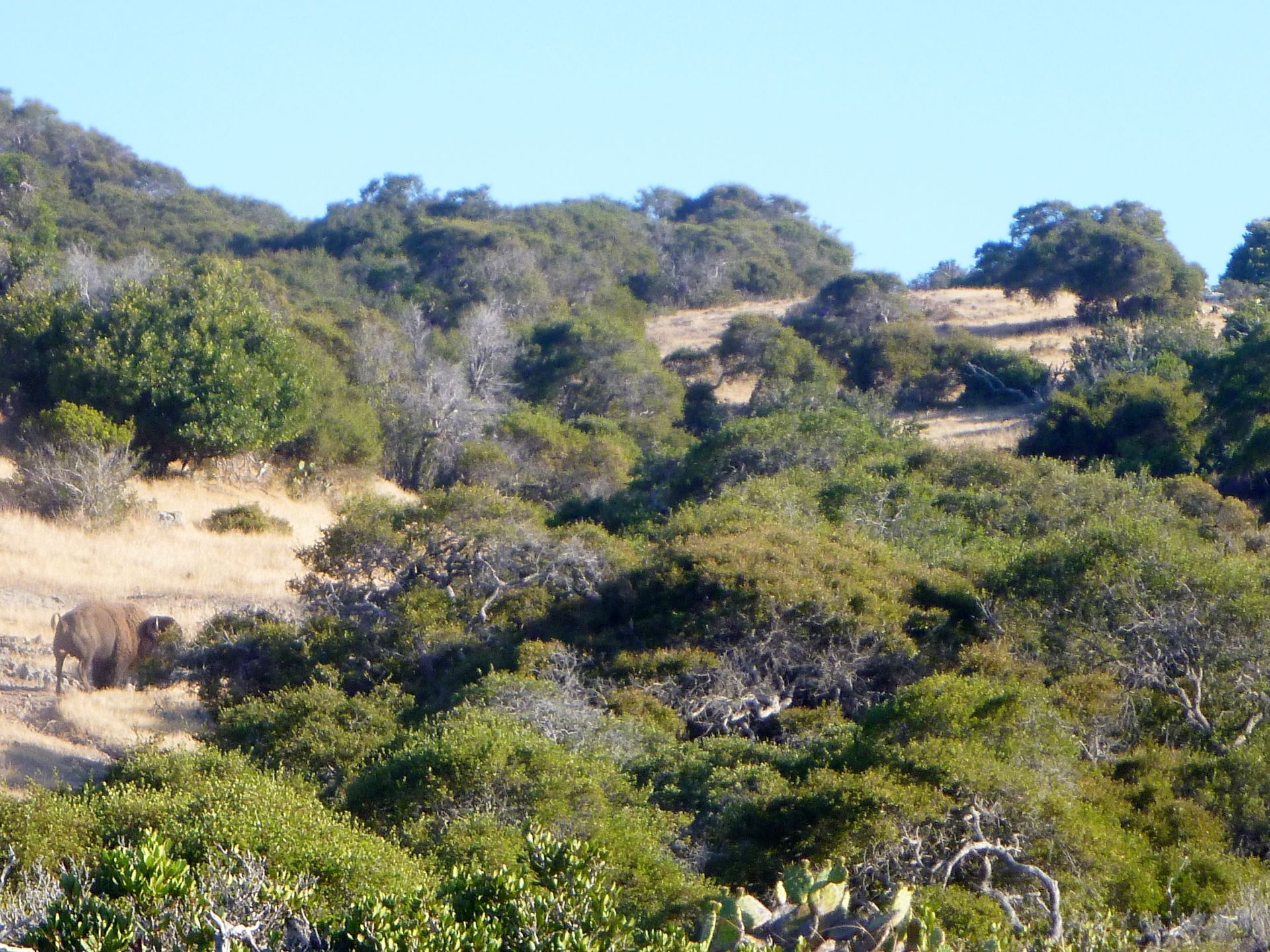
A buffalo roams on Catalina Island.
Then, in a series of miscalculated movements, Wendy manages to tip over the pot, resulting in all of our pasta sitting in a pile in the dirt. Wendy apologizes profusely, as though she’s just accidentally pushed the button sending nuclear missiles toward Cuba. Rich rushes over with the strainer, picks up the sticky, wet pasta from the ground, and pours a bottle of water over the noodles in the strainer to clean them. He’s John F. Kennedy.
Soon, we’re all wolfing down “Dirt Pasta,” which we find surprisingly tasty — though, our hunger is so immense after kayaking the entire length of Catalina’s northern coast that even the remaining dirt on the ground looks delicious. Aaron pulls a 1.5-liter Target Merlot wine cube out of his backpack, providing us with the perfect wine pairing for Dirt Pasta. While we eat in near darkness, we hear counselors at another nearby summer camp tell the campers to grab flashlights and start hiking. While yachts and sailboats sail below us and the violet sky, Wendy cuddles next to Rich, Bailey sidles up to Aaron, and Natalie huddles up next to me. Now in total darkness, we watch a seemingly-enchanted queue of lights, carried by the campers, slowly make its way to the top of a nearby ridge.
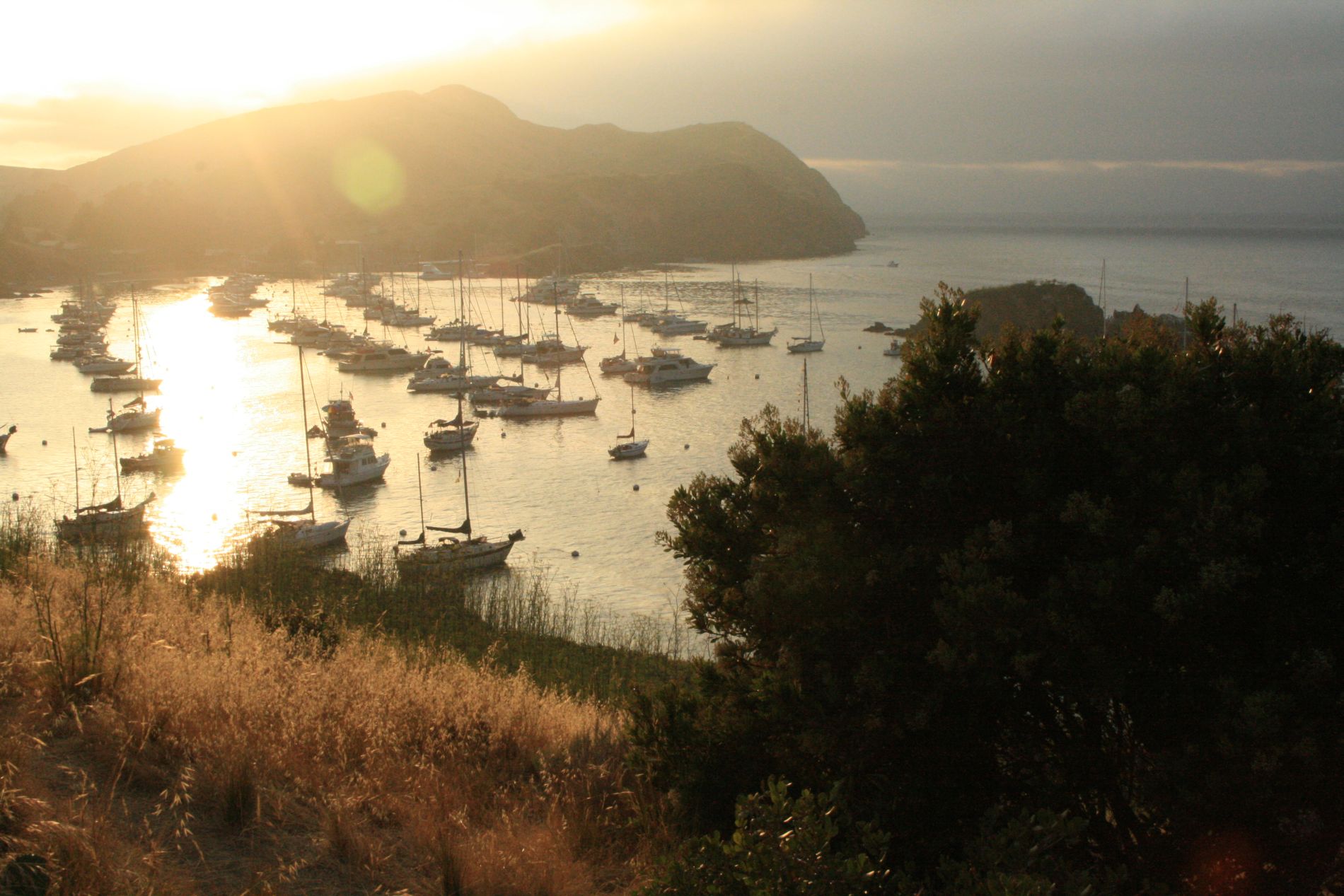
A view of Catalina Island’s Emerald Bay (photo by Wendy Eckersley)
I can’t contain myself for a second longer. All of our kayaking and hiking and camping has all led up to this.
“HAPPY JULY 4! BREAK. OUT. THE. PIE!” I demand. Starting weeks before our trip, I have been reminding Wendy and Rich daily that, for us to be truly American, we must watch fireworks and eat apple pie from the top of a mountain during our kayaking trip.
Quickly, I give our chef, Rich, the mysterious cardboard box from my bag. He opens it, revealing six miniature pies, and distributes them to the group.
“WAIT! WAIT!” I yell. We wait.
We hear a low-thud and a flash from a barge in the void below us, indicating that the first firework has been launched from Catalina’s Two Harbors into the night.
“NOW!” I shout.
Then, on the top of a mountain, watching a red starburst explode over the Pacific Ocean, we each take a bite of sweet apple pie.
“What could be more American than this?” I ask. There’s no response. Everyone’s mouth is full of pie.
How to Kayak Catalina Island
OVERVIEW: Catalina Island sits in the Pacific Ocean, and its largest town, Avalon, is 29 miles off the coast of Long Beach, California. The Island’s coastline extends about 54 miles. Kayaking the entire coastline takes at least four days. Our trip was a three-day, 35-mile trip from Avalon to Parsons Landing. The coastline on the northeastern side of the island is better protected and provides calmer kayaking water.
LOGISTICS: The Catalina Express, the ferry to Catalina Island, leave daily from San Pedro, Long Beach, and Dana Point (for San Diego dwellers) to Avalon and Two Harbors, the two towns on Catalina Island. Round trip tickets cost an obscene $69.50, proving that a world without ferry competition is a bad world indeed.
KAYAK RENTAL: Descanso Beach Ocean Sports in Avalon rents kayaks for overnight camping trips at about $35/day for single kayaks and $57/day for double kayaks from June 15 to October 16, and $24/day for single kayaks and $37/day for double kayaks from October 17 to June 14. Rentals include paddles and flotation jackets. Prices become considerably cheaper for longer trips. The sea kayaks rented by Descanso have large cargo areas underneath, big enough to hold at least two large backpacks full of gear and food. Use dry bags ($4/bag for rent) or large garbage bags to keep your belongings dry.
CAMPSITES: Catalina has five major campgrounds: Two Harbors, Parsons Landing, Blackjack, Little Harbor, and Hermit Gulch. The Island also has 17 boat-in-only campsites on the northeast shore. The campgrounds have running water, but the boat-in campsites have no access to water. At Parsons Landing, 2.5 gallons of water and a bundle of firewood is provided in a locker with your reservation, but you must pick up your locker key at the visitor’s center in Two Harbors.
ROUTE: On our first day, we kayaked 8.6 miles from Avalon to small beach cove Lava Wall. On our second day, we kayaked 9.5 miles from Lava Wall to Two Harbors to Parsons Landing. On our third day, we kayaked 16.7 miles from Parsons Landing all the way back to Avalon (we were completely exhausted by the end of this “double day”). We’re beginning sea kayakers who are reasonably fit, and we kayaked at about 3.5 miles per hour. View the route below or download the Without Baggage Catalina Island Kayak GPS track in GPX or KML format.